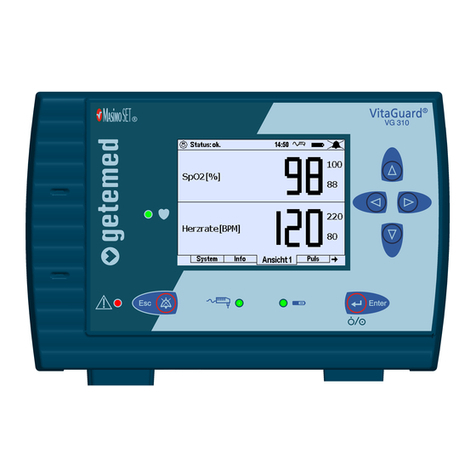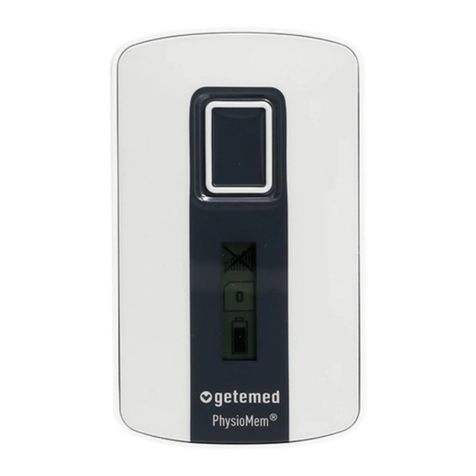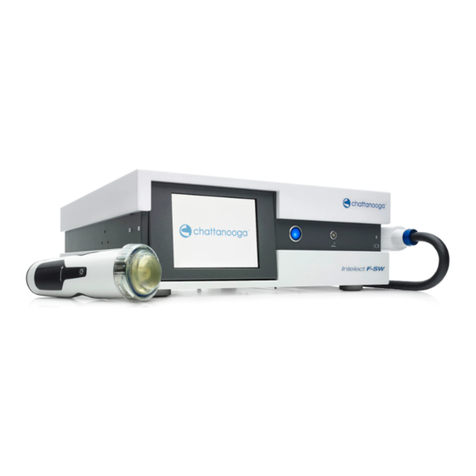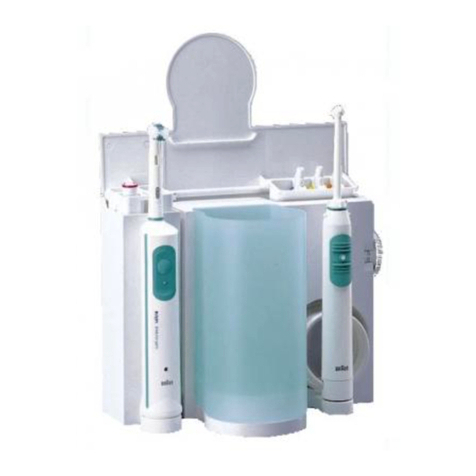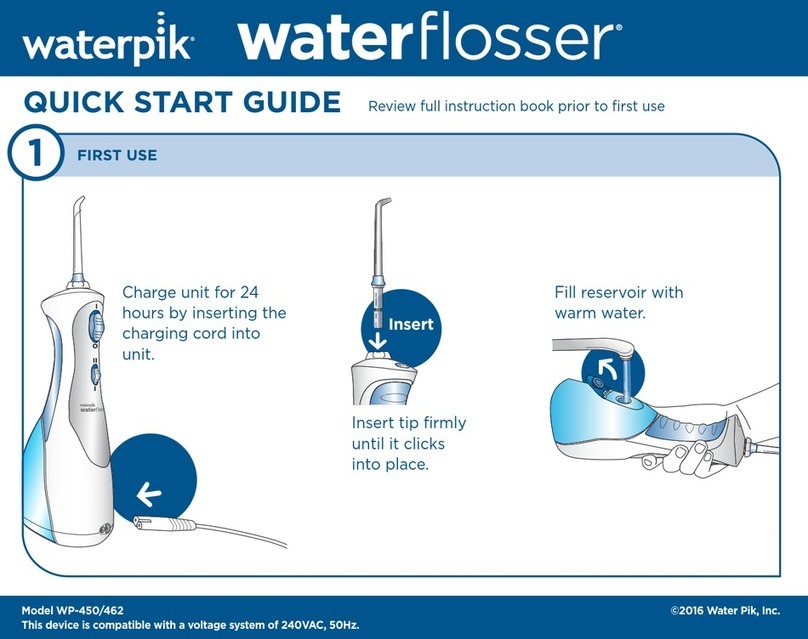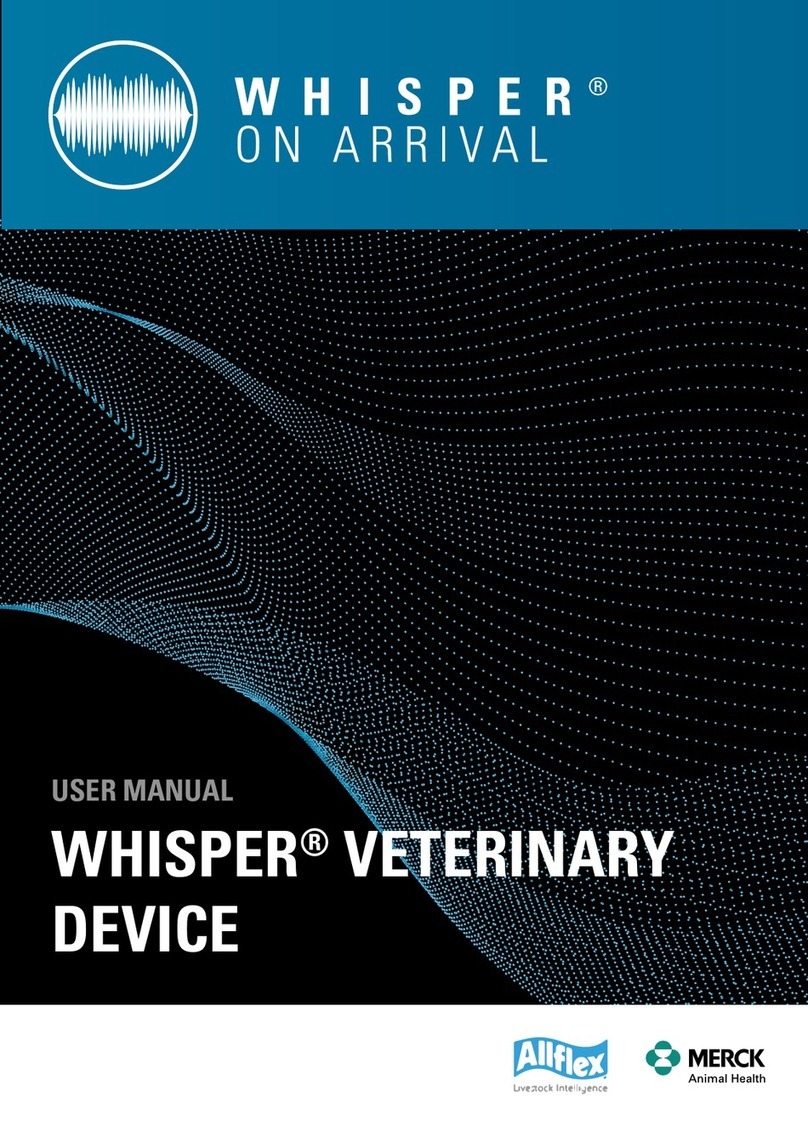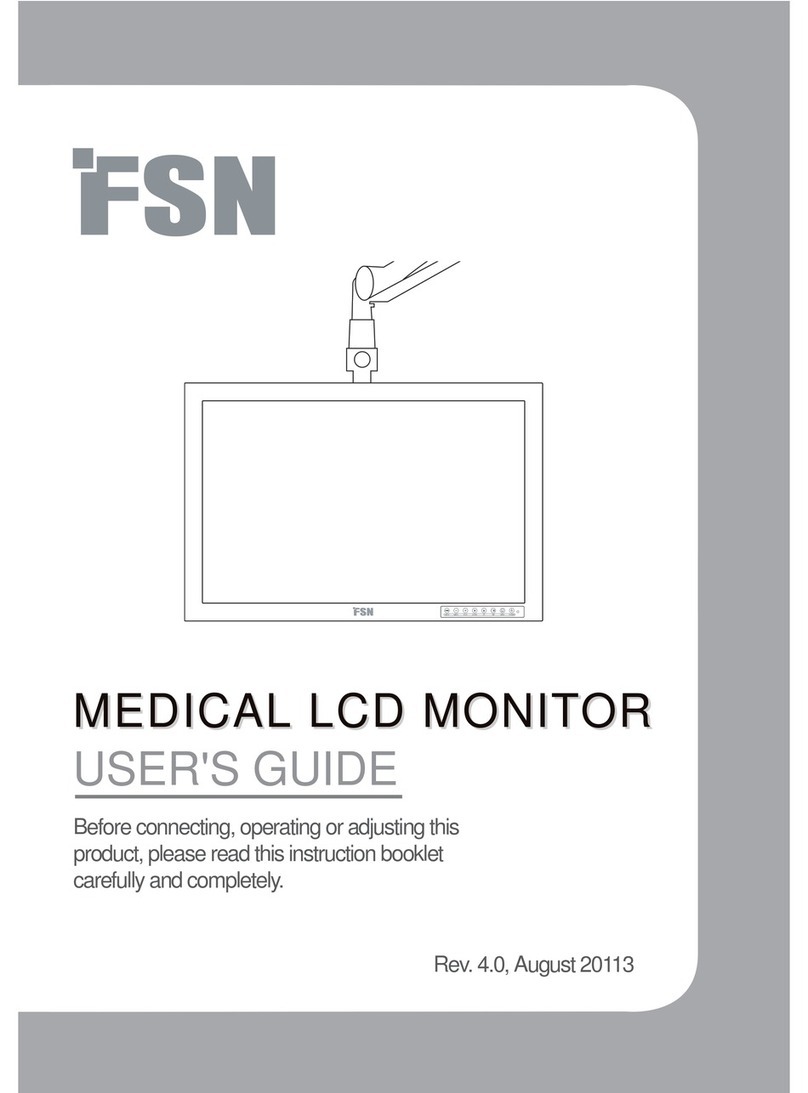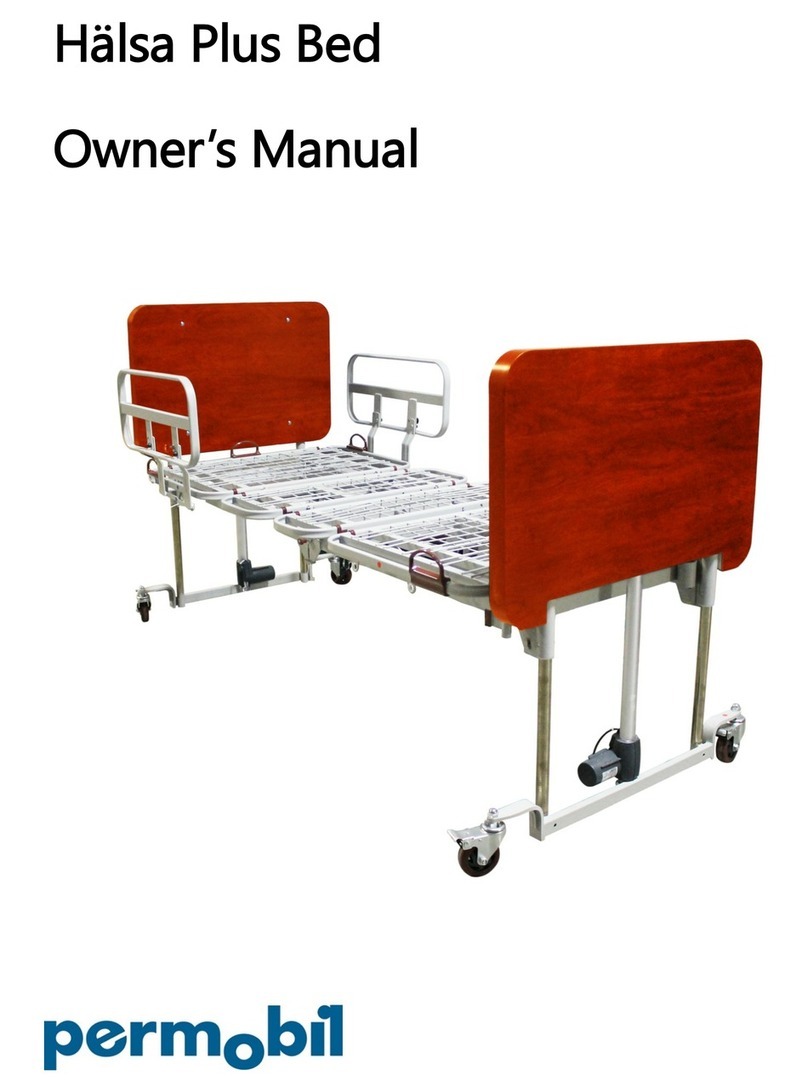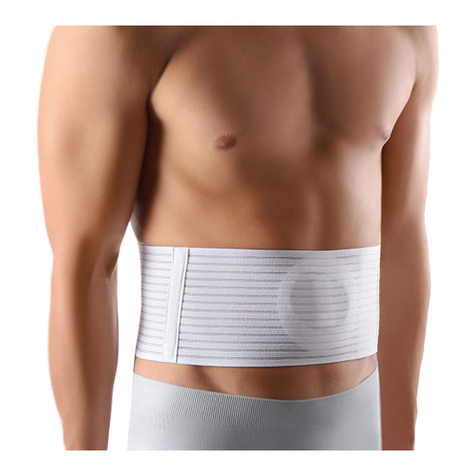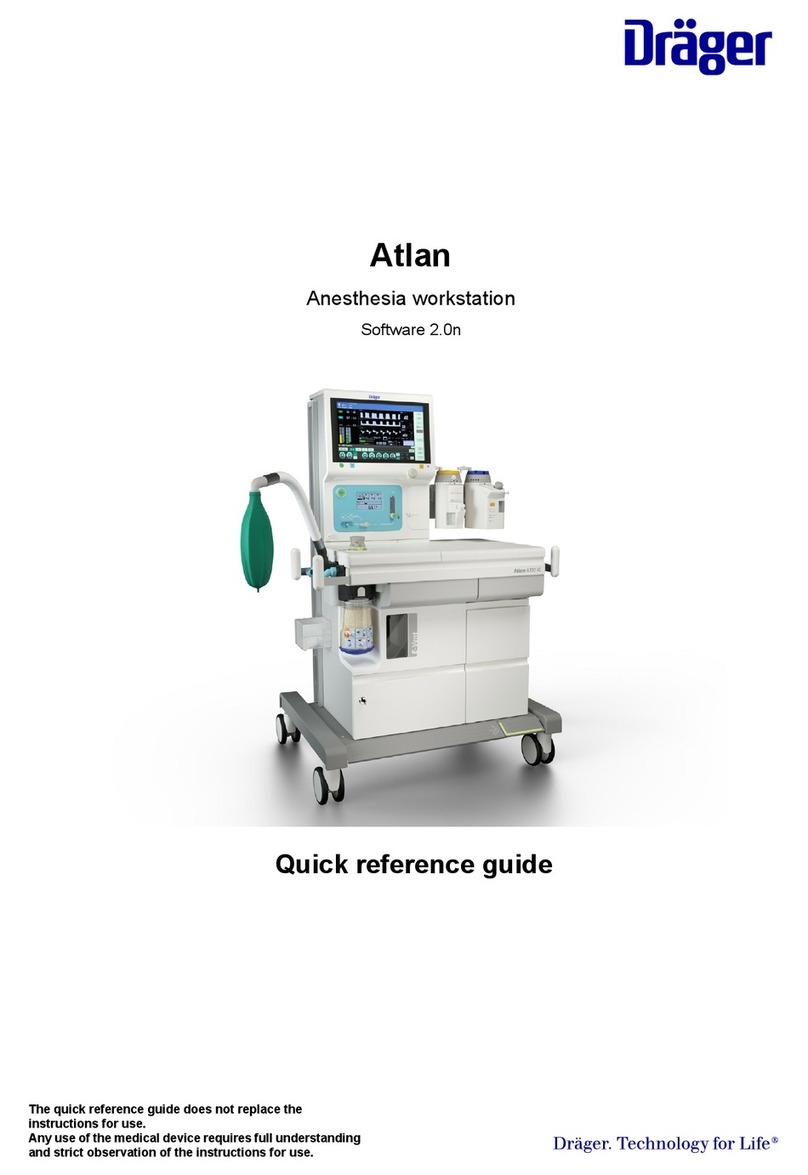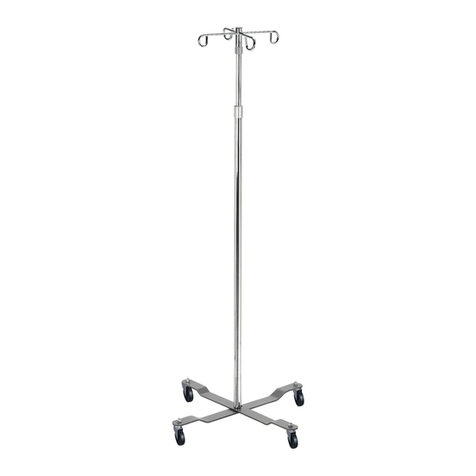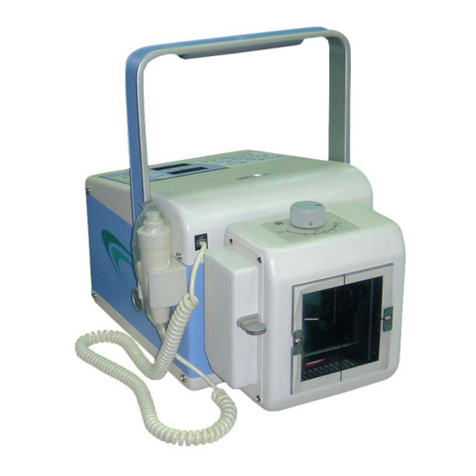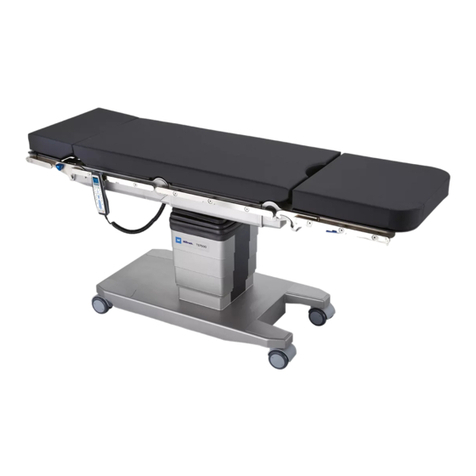getemed VitaGuard VG310 User manual

VitaGuard®VG310
Pulse oximeter
Operating instructions


Who should readwhich sections in these
operating instructions?
The sections 3to 7coloredblue atthetop ofthepage and in
the table of contents are intendedspecifically for caregivers
without medical background knowledge.
The other sections are intended in particular for doctors and
qualified medical staff.
1General view and list of accessories
2Intended use
3Safety
4Description
5Steps before and after monitoring
6Preparing for SpO2monitoring
7Alarms, displays, and views during monitoring
8Alarm and monitor settings
9Information for the doctor and qualified medical staff
10 Algorithms and measuring principles
11 Evaluating stored data on a PC
12 Specifications
13 Table of figures
NOTE Words and passages in small capitals in these operating
instructions also appearon the display.


Table of contents
Table of contents
1General view and list of accessories ...................................... 11
2Intended use .......................................................................................... 14
2.1 Label on the back of the device .............................................................. 14
2.2 Symbols and warnings .............................................................................. 14
2.3 Indications .................................................................................................... 16
2.4 Intended use and performance .............................................................. 16
2.5 Limitations on VitaGuard®’s intended use ......................................... 17
2.6 Information for the doctor on these operating instructions ......... 17
3Safety .......................................................................................................... 18
3.1 Caregivers’ tasks ......................................................................................... 18
3.2 Allergy risks to patients ............................................................................ 19
3.3 Possible external interference to monitoring .................................... 20
3.3.1 Installation and environment ................................................ 20
3.3.2 Noise risks to monitoring ........................................................ 21
3.3.3 Electrostatic interference ........................................................ 21
3.3.4 Electromagnetic interference ................................................. 21
3.4 Safety with approved accessories only ................................................ 23
3.5 Handling patient cables ........................................................................... 23
3.6 Power supply reliability ............................................................................ 24
3.6.1 Battery voltage indicator ......................................................... 25
3.6.2 Interruptions to the power supply ........................................ 26
3.6.3 Using the rechargeable block battery .................................. 26
3.7 Safety with proper maintenance only .................................................. 27
3.7.1 Cleaning VitaGuard® and accessories ................................. 27
3.7.2 Checking and cleaning the battery terminals ................... 28
3.8 Disposing of non-rechargeable batteries, the device, and
accessories .................................................................................................... 29
4Description .............................................................................................. 30
4.1 Power supply ................................................................................................ 31
4.1.1 Power failure with inserted batteries .................................. 32
4.1.2 Power failure without batteries ............................................ 32
4.1.3 Replacing batteries .................................................................... 33
4.1.4 Using the automobile power supply adapter .................... 34

Table of contents
4.2 VitaGuard® connections .......................................................................... 35
4.2.1 Patient cable for SpO2sensors ............................................... 35
4.2.2 Power adapter ............................................................................. 36
4.2.3 Sound outlet (no socket) .......................................................... 36
4.2.4 USB port ........................................................................................ 37
4.2.5 AUX port ....................................................................................... 37
4.3 Membrane key panel ................................................................................ 38
4.3.1 Direction keys .............................................................................. 39
4.3.2 <Enter> key ................................................................................... 39
4.3.3 <Esc> key ....................................................................................... 39
4.4 Color LEDs (Light Emitting Diodes) ....................................................... 40
4.4.1 Alarm LED ..................................................................................... 40
4.4.2 Heart LED ...................................................................................... 40
4.4.3 Power supply and battery LEDs ............................................. 41
4.5 The display ................................................................................................... 41
5Steps before and after monitoring ......................................... 43
5.1 Summary of steps before monitoring .................................................. 43
5.2 Switching on ................................................................................................ 43
5.3 Switching off ............................................................................................... 44
5.4 Summary of steps after monitoring ..................................................... 45
6Preparing for SpO2monitoring ................................................. 46
6.1 Safety instructions for SpO2monitoring ............................................. 46
6.2 Operation of SpO2sensors ...................................................................... 47
6.3 SpO2sensor adapted to the patient’s size and weight ................... 48
6.4 Choosing the sensor site .......................................................................... 48
6.5 Repositioning or replacing the sensor ................................................. 49
6.6 Reasons for unconvincing SpO2values ................................................ 49
6.7 Why the pulse rate is not displayed ..................................................... 50
6.8 Attaching the SpO2sensor to an infant’s foot .................................. 50
6.9 Attaching the SpO2sensor to an adult’s finger ................................ 51
6.10 Connecting the SpO2sensor and patient cable ................................ 53
6.11 Connecting the SpO2patient cable to VitaGuard® .......................... 53
6.12 Disconnecting the SpO2sensor from the patient cable ................. 54
6.13 Disconnecting the SpO2patient cable from VitaGuard® ............... 54
6.14 Reusing and refastening SpO2sensors ................................................ 54

Table of contents
7Alarms, displays, and views during monitoring ............ 56
7.1 Alarm test ..................................................................................................... 56
7.2 Pulse rate values based on age groups .............................................. 56
7.3 Alarm message priorities in the status line ........................................ 57
7.4 Physiological and technical alarms ....................................................... 57
7.5 Differentiating physiological and technical alarm signals ............ 58
7.6 Acoustic information signals .................................................................. 58
7.6.1 Information signals from the alarm unit next
to the display ............................................................................... 59
7.6.2 Information signals from the sound aperture
between the sockets ................................................................. 59
7.7 The visual alarm signals ........................................................................... 59
7.8 Status line displays .................................................................................... 59
7.9 SpO2monitor alarms ................................................................................ 60
7.9.1 Physiological SpO2alarms ....................................................... 60
7.9.2 Technical SpO2alarms .............................................................. 61
7.10 Pulse rate alarms ........................................................................................ 61
7.11 Alarm messages – meanings and other information ...................... 62
7.11.1 Order of equal-priority alarm conditions ............................ 62
7.11.2 Table of physiological alarm messages ............................... 62
7.11.3 Table of technical alarm messages ....................................... 64
7.12 Table of information messages .............................................................. 66
8Alarm and monitor settings ........................................................ 67
8.1 Safety instructions for the alarm settings .......................................... 67
8.2 Summary of views and menus ............................................................... 68
8.3 Additional views ......................................................................................... 68
8.3.1 View 2 – Large data presentation and waveforms .......... 69
8.4 Changing the settings ............................................................................... 69
8.5 System menu – general settings ............................................................ 70
8.5.1 \ Screen saver (Off/ On) ......................................................... 71
8.5.2 \LCDbrightness ....................................................................... 71
8.5.3 \LCDcontrast ........................................................................... 71
8.5.4 \ Signal beep tone ..................................................................... 71
8.5.5 \ Alarm tone pitch .................................................................... 72
8.5.6 \RS232format ........................................................................... 72

Table of contents
8.5.7 \ Settings protection On, Limited, Off ............................. 72
8.6 SpO2display and menu ............................................................................ 73
8.6.1 SpO2view ..................................................................................... 74
8.6.2 SpO2menu – alarm settings (Settings
protection Limited) .................................................................. 75
8.7 Pulse rate display and menu ................................................................. 76
8.7.1 Pulse rate display ...................................................................... 76
8.7.2 Pulse rate menu – alarm settings (Settings
protection Limited) .................................................................. 76
9Information for the doctor and qualified
medical staff .......................................................................................... 78
9.1 Safety instructions ..................................................................................... 78
9.1.1 Preparing for a new patient .................................................... 78
9.1.2 Connections to the USB and AUX ports .............................. 79
9.1.3 VitaGuard® and other medical devices ............................... 80
9.1.4 Safety instructions for the doctor – SpO2monitor .......... 81
9.2 Info display .................................................................................................. 81
9.2.1 \ Last status messages ............................................................ 82
9.2.2 \ General ...................................................................................... 82
9.2.3 \ Measurements: SpO2............................................................ 83
9.2.4 \ Measurements: Pulse rate ................................................. 84
9.2.5 \ Settings: Oximeter ................................................................ 84
9.2.6 \ Settings: Pulse rate .............................................................. 85
9.2.7 \ Memory/ Internet ................................................................. 85
9.2.8 \Versions .................................................................................... 85
9.3 Settings in the System menu (Settings protection Off) .............. 86
9.3.1 Changing multiple-component settings ............................ 86
9.3.2 \Operating area: Home or Clinic ......................................... 87
9.3.3 \Admitnewpatient– restoring factory settings ........... 87
9.3.4 \Pre-and Post-alarm time .................................................... 89
9.3.5 \ Alarm mute time .................................................................... 89
9.3.6 \Date/time ................................................................................. 90
9.3.7 \ Language .................................................................................. 90
9.3.8 \Analoginput1 + 2 ................................................................ 90
9.3.9 \ Interval recording ............................................................... 90

Table of contents
9.4 Data storage functions ............................................................................. 90
9.5 Event storage .............................................................................................. 91
9.5.1 Silent alarm limits ................................................................... 93
9.5.2 Manual data storage or Transmit data .......................... 93
9.5.3 Summary of stored Events ...................................................... 94
9.6 Trend storage .............................................................................................. 95
9.7 Long term storage over eight hours .................................................... 95
9.8 Protocol storage of operating and device data ............................... 95
9.9 Summary of stored signals and data .................................................... 96
9.10 Settings in the SpO2menu (Settings protection Off) ................... 97
9.11 Settings in the Pulse rate menu (Settings protection Off) ....... 99
10 Algorithms and measuring principles ..................................102
10.1 Alarm condition and report delays ........................................................102
10.2 Alarm report delays ....................................................................................102
10.3 Measuring principle for the SpO2monitor .........................................103
11 Evaluating stored data on a PC .................................................107
12 Specifications ........................................................................................109
12.1 General ..........................................................................................................109
12.2 SpO2and pulse rate monitor ..................................................................111
12.3 Intervals for calculating average values in the Info mask .............112
12.4 Memory .........................................................................................................112
12.5 Ports ................................................................................................................113
12.6 Miscellaneous ..............................................................................................113
12.7 Selection of applied standards ...............................................................114
13 Table of figures .....................................................................................115

Table of contents

General view and listof accessories 11
1 General view and list of accessories
The general view shows themonitoring system’smost important
components.
Fig. 1 General view of the monitoring system
The accessories listed in the following can be used together with
VitaGuard® andcan be orderedwith the specifiedarticle numbers
from getemed AG or authorized dealers. Please consult getemed AG
or your authorized dealer for other approved accessories.
VitaGuard®
monitor
SpO2
sensor
SpO2 patient
cable External
power adapter

12 General view and list of accessories
Product ........................................................................................ Article no. / REF
VitaGuard® VG310 Monitor (with Masimo SET®),
complete system ............................................................................... 7311 3022
1 VitaGuard® VG310 monitor
1 SpO2patient cable PC08
1 SpO2LNOP Neo sensor incl. spare adhesive strip
1 NA3000-2 external power adapter
1 rechargeable block battery
1 device bag
1 operating instructions, 1 quick reference
Transport case
NA3000-2 external power adapter
(110V–240V~/50–60Hz) ............................................................... 7344 1101
NAK3000-2 automobile power supply adapter .................... 7344 1201
Rechargeable block battery ........................................................... 7344 2201
Masimo SpO2patient cable PC08 (2.44 m) ...................................... 70257
Masimo LNOP® NeoPt SpO2sensor (PU = 20 pcs)
(for one patient use only, infants < 1 kg) .......................................... 70250
Masimo LNOP® Neo SpO2sensor (PU = 20 pcs)
(for one patient use only, infants < 10 kg) ........................................ 70251
Masimo LNOP® Pdt SpO2sensor (PU = 20 pcs)
(for one patient use only, pediatric/ slender finger 10–50 kg) . 70252
Masimo LNOP® Adt SpO2sensor (PU = 20 pcs)
(for one patient use only, adult > 30 kg) ........................................... 70253
Masimo LNOP® DCI reusable sensor (> 30 kg) ................................ 70254
Masimo LNOP® DCIP reusable sensor (10–50 kg) .......................... 70264
Other models are available in addition to the SpO2sensors listed here.

General view and listof accessories 13
Operating instructions (English) ................................................ 7381 3021
Alarm chart(English) ..................................................................... 7383 1021
Device bag ........................................................................................ 7345 1001
VitaGuard® transport case (forthe complete system) ........ 7391 0001
AUX 01 RS232 cable for connectingVitaGuard®
to a serial PC port ............................................................................ 7341 2002
AUX-02 modem cable for connectinga
modem to VitaGuard® .................................................................. 7341 3001
AUX-03 cable for connecting an external alarm unit
to VitaGuard® ................................................................................ 7341 5001
AUX-04 cable for connecting VitaGuard®
to a nurse callsystem with 4 kV isolation ............................... 7341 5011
AUX-06 cable forconnecting two external signal sources
to VitaGuard® .................................................................................. 7341 6001

14 Intended use
2 Intended use
This section provides information on the intended use of VitaGuard®
and the limitations of this intended use.
The doctor treating the patient is responsible for the application of
VitaGuard®. The specific “Information for thedoctorand qualified
medical staff” can be found on page 78.
getemed AG recommends qualified training for the caregivers in
potentially necessary resuscitationtechniques. Clearingtherespira-
tory tract and the resuscitation of babies and infants require particu-
lar know-how that the treating doctor should communicate to the
caregivers.
2.1 Label on the back of the device
The device label serves as a
uniqueidentifierforVitaGuard®.
In addition, the label bears im-
portant cautionary information.
On the device label you will
find the manufacturer’s name
and address as well as the
product and model name. The
serial number of your device is
given next to SN. Fig. 2 Device label on the bottom of thedevice
2.2 Symbols and warnings
This symbol warns you that failure to observe these op-
erating instructions can cause death or injury to the pa-
tient.

Intended use 15
The book symbol means that you must not use the de-
vice when you are not familiar with the information con-
tained in these operating instructions.
With this CE label and the CE approval number 0197
getemed AG confirms that VitaGuard® complies with all
the pertinent regulationsand in particular the require-
ments in Annex I of the Medical Devices Directive
93/42/EWG and that this has beenapproved by a noti-
fied body (TÜV RheinlandProduct Safety).
This symbol means that the VitaGuard®’s SpO2socket is
a type BF (body floating) application part that is pro-
tected against the effects of defibrillation.
The factory symbol shows the year of manufacture.
Like every electronic device, VitaGuard® and accessories
contain metal and plastic parts that must be disposed of
in such a way that they do not pollute the environment
after their service live. For this reason, the device andac-
cessories may be sent to getemed AG in an adequately
stamped package, when possible in the original packag-
ing, forfree and proper disposal.
Note the warnings on the device label.
Do not use in explosive atmospheres!
Use theNA 3000-2 power adapter only!
Warning: Do not connect to an electrical socket controlled by a wall
switch!
Only new alkaline batteries (LR6 or AA) must be used when the
device is powered by non-rechargeable batteries! Note the polarity!

16 Intended use
2.3 Indications
The SpO2and pulse rate monitor with the attached accessories is
suitable for the permanent, non-invasive monitoring of arterial blood
oxygen saturation (SpO2) and of the pulse rate as measured with the
SpO2sensor. The functional blood oxygen saturation displayed as
%SpO2is determined exclusively from themeasurements of oxygen-
ated and deoxygenated hemoglobin. The SpO2and pulse rate moni-
tor is suitable for adult, pediatric, and infant patients, in mobile or
stationary indoor and outdoor applications,including patients with
weak blood flow and those in hospitals and other institutions.
2.4 Intended use and performance
The intended use of VitaGuard® is to monitor the pulse rate as well as
the oxygen saturation. VitaGuard® is designed for applications at
home and in rooms used for medical purposes. VitaGuard® has no
therapeutic effect. VitaGuard® emits an acoustic and visual alarm
when the measured pulse rate and/or oxygen saturation values
violate the set alarm limits for a period set by the operator. The alarm
limits can be set within particular values specified by VitaGuard®.
Blood oxygen saturation and pulse rate are monitored with an SpO2
sensor suitable to the patient’s age and weight. When the signal
registered by the SpO2sensor is inadequate for the reliable meas-
urement of values, a message appears on the display.
Physiological data measured for a setperiod before and after an
alarm are stored and can afterwards be evaluated and documented.
VitaGuard® can be operated with theNA3000-2 power adapter (9 V),
the NAK3000-2 automobile power adapter (e.g. in the cigarette
lighter), four non-rechargeable batteries, or a rechargeable block
battery. Non-rechargeable batteries or the rechargeable block battery
serve above all to safeguard the monitor’s functions during a power
failure and to continue monitoring the heart rate and oxygen satura-
tion when patients are in transit.

Intended use 17
2.5 Limitations on VitaGuard®’s intended use
Even when operated in accordance with its intended use, VitaGuard®
cannot detect all life-threatening situations under certain unfavor-
ableconditions.
The monitoring of SpO2and pulse rate is adversely affected when the
patient moves vigorously or is vigorously moved.
When the sensor is not attached correctly, ambient light can falsify
measurements. One remedy is to cover the sensor witha dark or
opaque material.
The monitoroperates properly only when the SpO2sensor is correctly
attached.
2.6 Information for the doctor on these
operating instructions
In full knowledge of these operating instructions, the treating doc-
tor must decide:
whether the caregivers have to be trained in the performance of
resuscitation measures,
how the caregivers can be best prepared for monitoring and above
all for the measures that must be taken in the event of an alarm,
which view should be displayed
Information on Settings protection that sets the display modes and
user configurations can be found on page 72.
“Information for the doctor and qualified medical staff” is found on
page 78.

18 Safety
3 Safety
The doctor decides whether the caregivers are able to use VitaGuard®
for monitoring and whether they can implement appropriate meas-
ures in the eventof an alarm.
3.1 Caregivers’ tasks
With “caregivers”wemean those persons who are responsible during
monitoring for the monitored patient’s well-being, for example:
parents or other members of the family,
babysitters, when they too have been thoroughly prepared for the
situation,
nurses and other medically trained staff.
Observein particular theinformationin thosesections of theoper-
ating instructions that,like here, address you directly.
Observe the extensive safety instructions at the beginning of the
section “Preparing for SpO2monitoring” on page 46.
VitaGuard® has no therapeutic effect. You may have to implement
resuscitation measures in the event of an alarm.
The potential applications of VitaGuard® for high-risk patients are
so many and diverse that we are unable to give any specific instruc-
tions on procedure in the event of an alarm. It is the doctor’s task to
inform high-risk patients and their caregivers in detail on the correct
procedure in this case.
An alarmchartis available from getemed AG whenmonitoring
children. This alarm chart presents a sequence of activities that are
considered suitable by many medical specialists and pediatricians.
Never leave the patient’s room without first makingsure that the
heart LEDis flashing.

Safety 19
Make absolutelysure that you can reactto an alarm within a few
seconds. Move away from patients only so far that you can reach
them within ten seconds.
Never modify settings without consulting the responsibledoctor.
Only the doctor knows the correct alarm limits and monitor configu-
ration for each patient.
When you are not sure that VitaGuard® is in perfect operating order,
check thepatient’s vital functions. Under no circumstances should
you use VitaGuard® when you suspect a device defect.
In the event of ANY suspected VitaGuard® malfunction, continue to
observe the patient until you can usea replacement monitor, or
VitaGuard® has been examined by the doctor or authorized dealer.
Stop using VitaGuard® after the servicing interval of eighteen
months hasexpired. Before theendof this period, make an ap-
pointment with your authorized dealer to check the safety and
operability of your device.
Test the acoustic alarm unit every time you switch on VitaGuard®.
This is explained in the section “Alarm test” on page 56.
Treat all leads and connections with particular care, and never use
the connecting cables to lift VitaGuard®.
Switch off VitaGuard® before boarding an aircraft. When you want
to transport VitaGuard® in your luggage, you should remove the
batteries. This prevents other pieces of luggage from switching on
the device by accident. An activated, but disconnected VitaGuard®
will generate acoustic alarm signals.
3.2 Allergy risks to patients
Attach SpO2sensors to intact areas of skin only.
The use of SpO2sensors with adhesive materials may cause problems
when the patient develops an allergyto adhesive tape or similar.

20 Safety
All materials thatare used with VitaGuard® and can come into con-
tact with patient or caregivers during normal operations are free of
latex and are non-toxic in accordance with the standard ISO 10993-1.
3.3 Possible external interference to monitoring
Please bear in mind the possibility ofother risks that are notlisted
here that can be caused by your specific monitoring environment.
3.3.1 Installation and environment
We recommend hanging VitaGuard®in the delivered bag at a place
where the display canbe easily viewed.
Check, as described in the section “Alarm test” on page56, that you
can hear alarmsand whereyou canhear them. Think also of the
activities that causenoises, for example showering or vacuuming.
Think before you raise thevolume of your television orstereo. Also,
the VitaGuard®’s alarm outlet should not be obstructed by any
objects that absorb sound.
Never place VitaGuard® or the poweradapter such that they could
fall on the patient. For example, the power adapter could become
detached from an overhead socket when the cable is pulled.
Do not immerse either VitaGuard® or the accessories in liquids.
Variationsin temperature and air humidity could leadto condensation
forming inand on VitaGuard®. Wait for at least two hours after Vita-
Guard® has visibly dried onthe outsidebeforeusingit formonitoring.
Do not operate VitaGuard® in environments containing explosive
gases, flammable substances, nitrous gases, or highly oxygen-en-
riched atmospheres. Do not use VitaGuard®atextreme temperatures
below5 °C orabove40 °C. Do notplace VitaGuard®near heat sources
such as radiators,ovens, etc. Donot expose it to directsunlight.
Other manuals for VitaGuard VG310
1
Table of contents
Other getemed Medical Equipment manuals
Popular Medical Equipment manuals by other brands

Tecno-gaz
Tecno-gaz MasterFluxSmart Instructions for use

Deta-Elis
Deta-Elis DeVita BRT manual
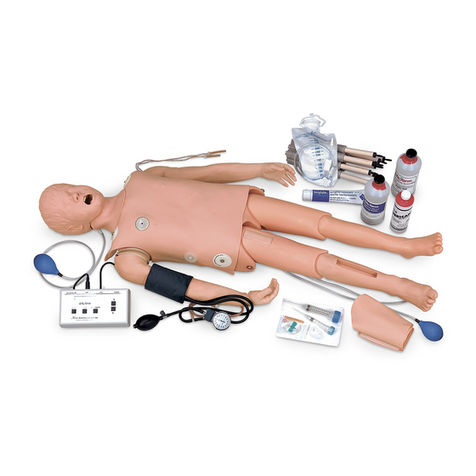
Nasco
Nasco CRiSis LF03616U instruction manual
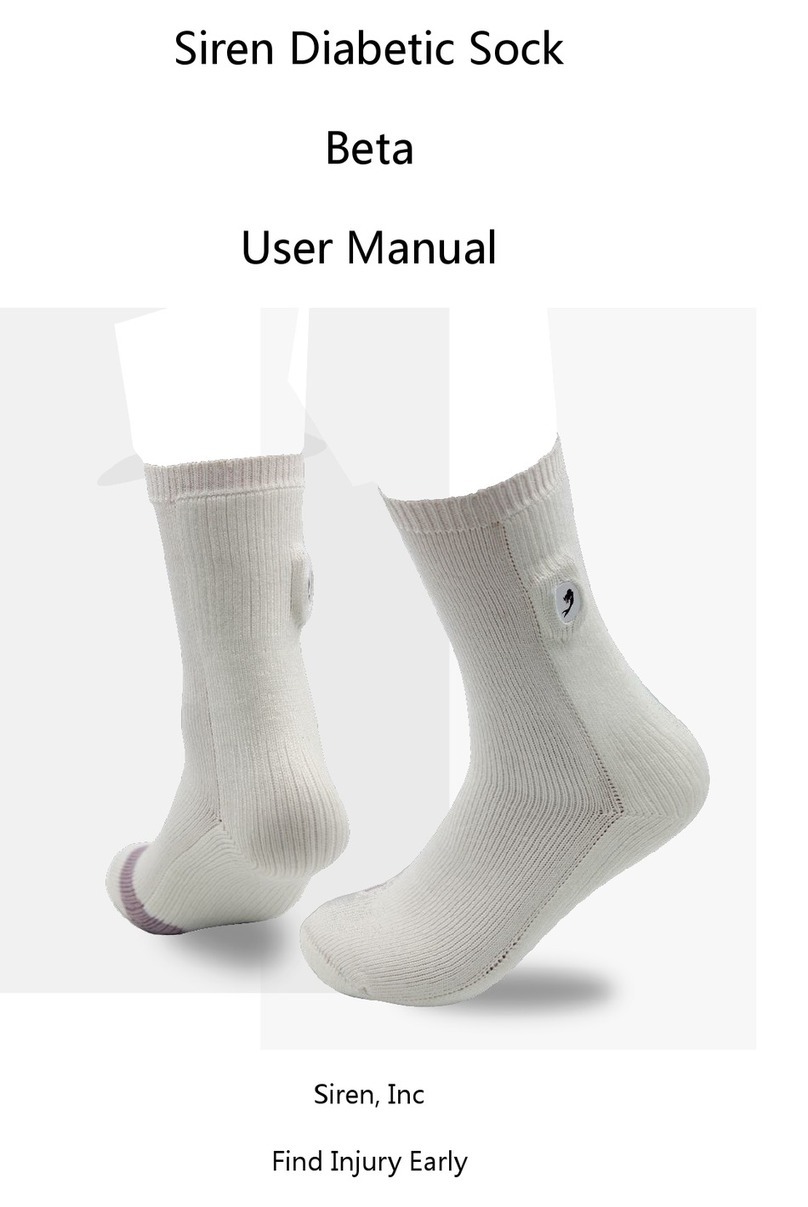
Siren
Siren Diabetic Sock user manual
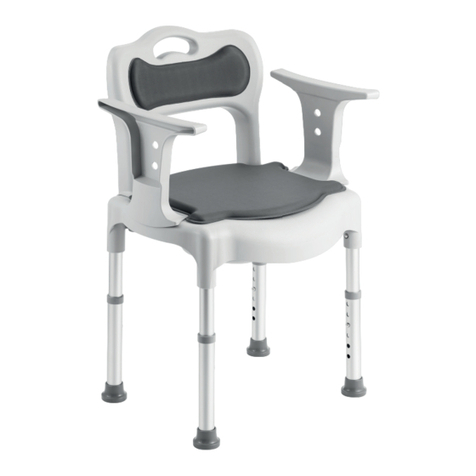
DeVilbiss Healthcare
DeVilbiss Healthcare drive SUVA Instructions for use
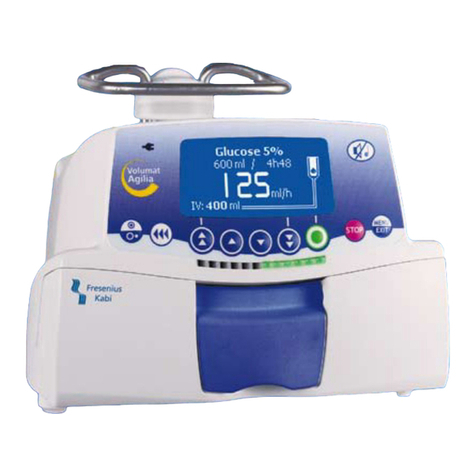
Fresenius Kabi
Fresenius Kabi Volumat Agilia Technical manual
